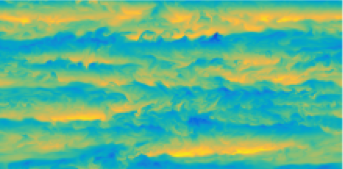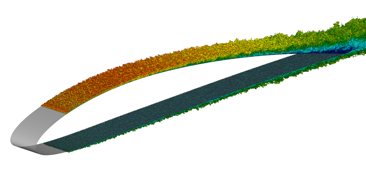Turbulence and Geophysical Flows
Simulations and Experiments of Turbulence
Introduction
Turbulent flows play an important role in many industrial processes as well as in our environment and climate. However, no exact solution is known to the equations describing the motions of turbulent flows. Researchers are therefore using tools like direct numerical simulations (DNS), large-eddy simulations (LES), experimental measurements and theory to obtain a better understanding of turbulent flows as well as e.g. turbulent heat transfer and particle transport. Other topics of interest are the influence of buoyancy (stable and unstable density stratification) and rotation on flows since these influences are important in geophysical flows. With the help of the gathered knowledge, models for turbulent flows and turbulent transport processes can be developed. Such models are used, for example, in industry for research and development and in climate models.

|

|
Figure 1: Overview of the activities within the turbulence research area: a) Visualisation of the instantaneous buoyancy field in a DNS of stratified turbulence. b) The flow around a NACA-4412 airfoil, visualised using the negative lambda-2 criterion.
Research overview
The direction of our research in the area of turbulent and geophysical flows is towards enhanced physical understanding of turbulent flows in various geometries and the effects of rotation and buoyancy on flows. An additional aim is to develop turbulence models.
Turbulent wall-bounded flows. We use DNS, LES and experiments to investigate turbulent boundary layers with and without pressure gradients and turbulent wall-bounded flows in several geometries. The short-term goals in this area are:
- To investigate the influence of a system rotation on turbulent channel and Couette flow
- To investigate the effect of wall curvature on a turbulent flow
- To investigate the effect of pressure gradients on boundary-layer flows
- To extend the study of basic turbulence to more complex flows of engineering interest, such as airfoils
Geophysical flows. The main aim is to obtain a better understanding of the influences of stable density stratification and rotation on flows. An important tool is DNS but also experiments are used. Moreover, atmospheric data from measurements taken during flights are analysed. The short-term goals are:
- To study the effect of a stable density stratification on the flow, turbulence and mixing
- Develop new boundary conditions to accurately simulation atmospheric boundary layers
- Understand the influence of wind turbines in atmospheric boundary layers
Turbulence modelling. In recent years, the main focus has been to develop and validate subgrid-scale (SGS) models for LES and to develop a model for the atmospheric boundary layer. The purpose is to develop models that can be used for engineering applications and for climate models. The short term goals are:
- To apply and validate the recently, in our group developed explicit algebraic SGS stress model in LES of flows in complex geometries
- To compare LES with the algebraic SGS stress model with LES using other SGS models
- To further develop and validate the explicit algebraic Reynolds stress model for the atmospheric boundary layer.
Research environment
The active groups in this field apply a range of methods to investigate turbulent and geophysical flows; DNS, LES, experiments and theory. Another important activity is developing turbulence models for Reynolds averaged Navier-Stokes methods and the subgrid-scales in LES. Regularly, there is a close coordination between the numerical, experimental, theoretical and modelling work.
Research groups
- Group of Arne Johansson ( link )
- Group of Erik Lindborg ( link )
- Group of Philipp Schlatter ( link )
- Group of Henrik Alfredsson ( link )
Facilities
- The Minimum-Turbulence-Level (MTL) wind tunnel, which was inaugurated in 1990, has proven to be a world-class resource for studies of turbulent boundary layers (link)
- FLOW centre has access to the different super-computer resources managed by the Swedish Centre for Infrastructures (SNIC). (link)
- Access to larger-scale European HPC facilities using for instance PRACE (link)
- A number of research codes, maintained and developed within the FLOW Centre
Collaborating organizations
University of Washington, Delft University of Technology, Argonne National Laboratory, Karlsruhe Institute of Technology, University of Adelaide, Univ. of Illinois at Urbana-Champaign
Key publications
Schlatter, Philipp, and Ramis Örlü. "Turbulent boundary layers at moderate Reynolds numbers: inflow length and tripping effects." Journal of Fluid Mechanics 710 (2012): 5-34.
Lenaers, Peter, et al. "Rare backflow and extreme wall-normal velocity fluctuations in near-wall turbulence." Physics of fluids24.3 (2012): 035110.
Hosseini, Seyed Mohammad, et al. "Direct numerical simulation of the flow around a wing section at moderate Reynolds number." International Journal of Heat and Fluid Flow 61 (2016): 117-128.
Wallin, Stefan, and Arne V. Johansson. "An explicit algebraic Reynolds stress model for incompressible and compressible turbulent flows." Journal of Fluid Mechanics 403 (2000): 89-132.
Örlü, R., Fiorini, T., Segalini, A., Bellani, G., Talamelli, A., & Alfredsson, P. H. (2017). Reynolds stress scaling in pipe flow turbulence—first results from CICLoPE. Phil. Trans. R. Soc. A, 375(2089), 20160187.
Imayama, S., Lingwood, R. J., & Alfredsson, P. H. (2014). The turbulent rotating-disk boundary layer. European Journal of Mechanics-B/Fluids, 48, 245-253.
Deusebio, E., Brethouwer, G., Schlatter, P., & Lindborg, E. (2014). A numerical study of the unstratified and stratified Ekman layer. Journal of Fluid Mechanics, 755, 672-704.
